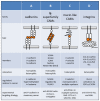Oncogenic Deregulation of Cell Adhesion Molecules in Leukemia
- PMID: 30841639
- PMCID: PMC6468598
- DOI: 10.3390/cancers11030311
Oncogenic Deregulation of Cell Adhesion Molecules in Leukemia
Abstract
Numerous cell⁻cell and cell⁻matrix interactions within the bone marrow microenvironment enable the controlled lifelong self-renewal and progeny of hematopoietic stem and progenitor cells (HSPCs). On the cellular level, this highly mutual interaction is granted by cell adhesion molecules (CAMs) integrating differentiation, proliferation, and pro-survival signals from the surrounding microenvironment to the inner cell. However, cell⁻cell and cell⁻matrix interactions are also critically involved during malignant transformation of hematopoietic stem/progenitor cells. It has become increasingly apparent that leukemia-associated gene products, such as activated tyrosine kinases and fusion proteins resulting from chromosomal translocations, directly regulate the activation status of adhesion molecules, thereby directing the leukemic phenotype. These observations imply that interference with adhesion molecule function represents a promising treatment strategy to target pre-leukemic and leukemic lesions within the bone marrow niche. Focusing on myeloid leukemia, we provide a current overview of the mechanisms by which leukemogenic gene products hijack control of cellular adhesion to subsequently disturb normal hematopoiesis and promote leukemia development.
Keywords: CAM; adhesion; integrin; leukemia; oncogene.
Conflict of interest statement
The authors declare no conflict of interest.
Figures




Similar articles
-
Leukemia cells impair normal hematopoiesis and induce functionally loss of hematopoietic stem cells through immune cells and inflammation.Leuk Res. 2018 Feb;65:49-54. doi: 10.1016/j.leukres.2018.01.002. Epub 2018 Jan 2. Leuk Res. 2018. PMID: 29306107
-
Pathogenic Mechanisms in Acute Myeloid Leukemia.Curr Treat Options Oncol. 2022 Nov;23(11):1522-1534. doi: 10.1007/s11864-022-01021-8. Epub 2022 Oct 3. Curr Treat Options Oncol. 2022. PMID: 36190670 Review.
-
Transformation of Hematopoietic Stem and Progenitor Cells by Leukemia Extracellular Vesicles: A Step Toward Leukemogenesis.Stem Cell Rev Rep. 2020 Dec;16(6):1081-1091. doi: 10.1007/s12015-020-09975-8. Stem Cell Rev Rep. 2020. PMID: 32500481 Review.
-
IGF signaling contributes to malignant transformation of hematopoietic progenitors by the MLL-AF9 oncoprotein.Exp Hematol. 2012 Sep;40(9):715-723.e6. doi: 10.1016/j.exphem.2012.05.003. Epub 2012 May 18. Exp Hematol. 2012. PMID: 22613471
-
Regulation of hematopoietic and leukemic stem cells by the immune system.Cell Death Differ. 2015 Feb;22(2):187-98. doi: 10.1038/cdd.2014.89. Epub 2014 Jul 4. Cell Death Differ. 2015. PMID: 24992931 Free PMC article. Review.
Cited by
-
Cadherins, Selectins, and Integrins in CAM-DR in Leukemia.Front Oncol. 2020 Dec 10;10:592733. doi: 10.3389/fonc.2020.592733. eCollection 2020. Front Oncol. 2020. PMID: 33425742 Free PMC article. Review.
-
PVR and ICAM-1 on Blast Crisis CML Stem and Progenitor Cells with TKI Resistance Confer Susceptibility to NK Cells.Cancers (Basel). 2020 Jul 16;12(7):1923. doi: 10.3390/cancers12071923. Cancers (Basel). 2020. PMID: 32708713 Free PMC article.
-
Mechanisms associated with t(7;12) acute myeloid leukaemia: from genetics to potential treatment targets.Biosci Rep. 2023 Jan 31;43(1):BSR20220489. doi: 10.1042/BSR20220489. Biosci Rep. 2023. PMID: 36622782 Free PMC article. Review.
-
Acute Myeloid and Lymphoblastic Leukemia Cell Interactions with Endothelial Selectins: Critical Role of PSGL-1, CD44 and CD43.Cancers (Basel). 2019 Aug 27;11(9):1253. doi: 10.3390/cancers11091253. Cancers (Basel). 2019. PMID: 31461905 Free PMC article.
-
Targeting Abnormal Hematopoietic Stem Cells in Chronic Myeloid Leukemia and Philadelphia Chromosome-Negative Classical Myeloproliferative Neoplasms.Int J Mol Sci. 2021 Jan 11;22(2):659. doi: 10.3390/ijms22020659. Int J Mol Sci. 2021. PMID: 33440869 Free PMC article. Review.
References
-
- Zhang C.C., Yan Z., Zhang Q., Kuszpit K., Zasadny K., Qiu M., Painter C.L., Wong A., Kraynov E., Arango M.E., et al. PF-03732010: A fully human monoclonal antibody against P-cadherin with antitumor and antimetastatic activity. Clin. Cancer Res. 2010;16:5177–5188. doi: 10.1158/1078-0432.CCR-10-1343. - DOI - PubMed
Publication types
LinkOut - more resources
Full Text Sources

